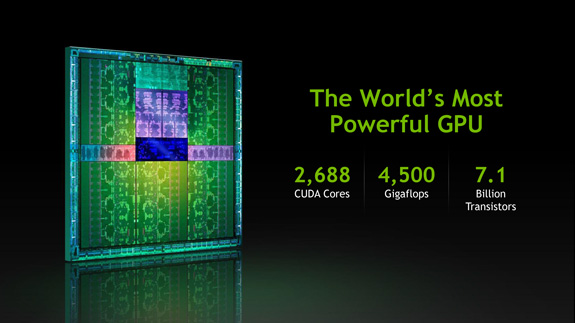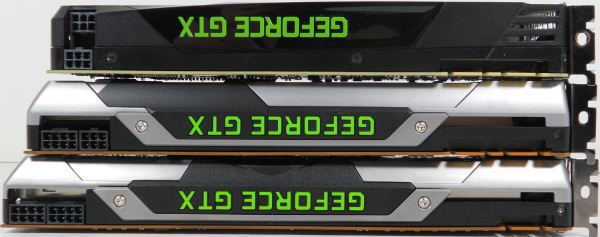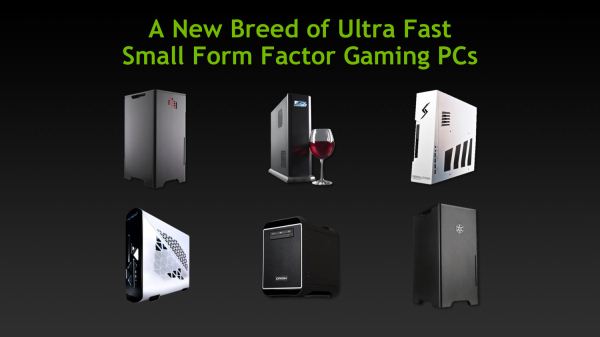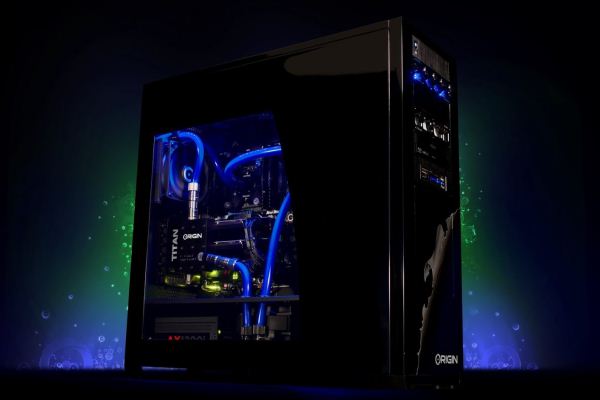NVIDIA's GeForce GTX Titan, Part 1: Titan For Gaming, Titan For Compute
by Ryan Smith on February 19, 2013 9:01 AM ESTWho’s Titan For, Anyhow?
Having established performance expectations, let’s talk about where Titan fits into NVIDIA’s product stack. First and foremost, though Titan is most certainly geared in part as a gaming video card (and that’s largely how we’ll be looking at it), that’s not the only role it serves. Titan is also going to be NVIDIA’s entry-level compute card. We’ll dive more into why that is in a bit in our feature breakdown, but the biggest factor is that for the first time on any consumer-level NVIDIA card, double precision (FP64) performance is uncapped. That means 1/3 FP32 performance, or roughly 1.3TFLOPS theoretical FP64 performance. NVIDIA has taken other liberties to keep from this being treated as a cheap Tesla K20, but for lighter workloads it should fit the bill.
As compared to the server and high-end workstation market that Tesla carves out, NVIDIA will be targeting the compute side of Titan towards researchers, engineers, developers, and others who need access to (relatively) cheap FP64 performance, and don’t need the scalability or reliability that Tesla brings. To that end Titan essentially stands alone in NVIDIA’s product stack; the next thing next to a FP64-constrained consumer card is the much more expensive Tesla K20.

Far more complex will be the gaming situation. Titan will not be pushing anything down in NVIDIA’s product stack, rather NVIDIA’s product stack will be growing up to accompany Titan. Like the GTX 690, NVIDIA is going to position Titan as a premium/luxury product, releasing it at the same $999 price point. GTX 690 itself will continue to exist at the same $999 price point, meanwhile GTX 680 will continue at its current price point of roughly $450.
Continuing the GTX 690 analogies, Titan will not only be sharing in GTX 690’s price point, but also in its design principles and distribution. This means Titan is a well-built card with its housing composed primarily of metals, with the same kind of luxury finish as the GTX 690. On the distribution side of things Asus and EVGA are once again NVIDIA’s exclusive partners for North America, and they will essentially be distributing reference Titan cards. In time we will see some specialized variation, with water-cooling in particular being an obvious route for EVGA to go. Factory overclocks are also on the table.
With the above in mind, it goes without saying that while GTX 690 had some historical precedence in its price, the same cannot be said for Titan. The price of NVIDIA’s top-tier single-GPU video cards hovered around $500 for the GeForce 400/500 series, and while they attempted to launch at $650 for the GTX 280, the launch of the Radeon HD 4870 quickly brought that price down to earth. As such this will be the most expensive single-GPU product out of NVIDIA yet.

Top To Bottom: GTX 680, GTX Titan, GTX 690
Ultimately NVIDIA is not even going to try to compete on a price-performance basis with Titan. There are a number of potential reasons for this – ranging from the competitive landscape to yields to needs for GK110 GPUs elsewhere within NVIDIA – and all of those reasons are probably true to some extent. Regardless, NVIDIA believes that like the GTX 690 they can sell Titan as a luxury product, and hence $999. The GTX 680 and below will compose NVIDIA’s more traditional price-performance competitive fare.
As to be expected from such a price, NVIDIA’s marketing department will be handling Titan in a similar fashion as they did GTX 690. This not only includes reiterating the fact that Titan is intended to be a luxury product, but also focusing on markets where luxury products are accepted, and where Titan in particular makes sense.
Perhaps not surprisingly, with $999 video cards the makeup of consumers shifts away from both traditional big-box OEMs and DIY builders, and towards boutique builders. Boutique builders are essentially already in the business of providing luxury computers, offering an outlet for luxury buyers who need not spend their time building their own computer, and want something of higher quality than what the typical OEM provides. As such while Titan will be sold on the open market just as like any other card, NVIDIA tells us that they expect a lot of those buyers are going to be the boutiques.
For Titan in particular, NVIDIA is going to be focusing on two boutique computer concepts, reflecting the blower design of Titan as opposed to the front/back exhausting design of the GTX 690. The first concept will be SFF PCs, where blowers are a necessity due to a lack of space (and often, a lack of heavy sound dampening), and where such cards can draw fresh air in from outside the chassis.
On the other end of the spectrum will be the ultra-enthusiast market where one Titan isn’t enough, and even two may come up short. Again thanks to the fact that it’s a blower, Titan can easily be fit in an ATX motherboard for tri-SLI operation, which NVIDIA envisions not just as the ultimate gaming computer, but the ultimate NV/3D Surround computer in particular. Multi-monitor gaming with graphically intensive games can quickly nullify the performance of even a single Titan card, so tri-SLI is NVIDIA’s solution to driving three monitors as well as one Titan can drive one monitor. At the same time however, NVIDIA intends to showcase that a tri-SLI system doesn’t need to be loud, despite the cramped conditions and despite the 750W+ that 3 Titans will pull, thanks to the high quality construction of the cards. Tri-SLI has been possible for a number of years, but NVIDIA believes with Titan in particular they have a solid grip on the heat and noise concerns it typically comes with.
To that end, as part of the Titan launch NVIDIA has shipped out a number of boutique systems in either a SFF or tri-SLI full tower configuration to reviewers, in order to show off their usage concepts in completed and well-constructed systems. Anand received a SFF Tiki from Falcon Northwest, while I have received a tri-SLI equipped Genesis from Origin PC. Like Titan itself we can’t talk about the performance of these systems, but we’ll be able to go into greater detail on Thursday when the complete NDA lifts. In the meantime we’ve been able to post a few impressions, which we’ve put up on their respective articles.
Moving on, with a $999 launch price NVIDIA’s competition will be rather limited. The GTX 690 is essentially a companion product; NVIDIA’s customers can either get the most powerful single-GPU card NVIDIA offers in a blower design, or an alternative design composed of two lesser GPUs in SLI, in a front and rear exhausting design. The GTX 690 will be the faster card, but at a higher TDP and with the general drawbacks of SLI. On the other hand Titan will be the more consistent card, the lower TDP card, the easier to cool card, but also the slower card. Meanwhile though it’s not a singular product, the GTX 680 SLI will also be another option, offering higher performance, higher TDP, more noise, and a cheaper price tag of around $900.
As for AMD, with their fastest single-GPU video card being the 7970 GHz Edition, offering performance closer to the GTX 680 than Titan, Titan essentially sits in a class of its own on the single-GPU front. AMD’s competition for Titan will be the 7970GE in CrossFire, and then the officially unofficial 7990 family, composed of the air-cooled PowerColor 7990, and the closed loop water-cooled Asus Ares II. But with NVIDIA keeping GTX 690 around, these are probably closer competitors to the multi-GPU 690 than they are the single-GPU Titan.
Finally, let’s talk launch availability. By scheduling the launch of Titan during the Chinese New Year, NVIDIA has essentially guaranteed this is a delayed availability product. Widespread availability is expected on the 25th, though cards may start popping up a couple of days earlier. NVIDIA hasn’t gone into depth for launch quantities, but they did specifically shoot down the 10,000 card rumor; this won’t be a limited run product and we don’t have any reason at this time to believe this will be much different from the GTX 690’s launch (tight at first, but available and increasingly plentiful).
| February 2013 GPU Pricing Comparison | |||||
| AMD | Price | NVIDIA | |||
| $1000 | GeForce GTX Titan/690 | ||||
| (Unofficial) Radeon HD 7990 | $900 | ||||
| Radeon HD 7970 GHz Edition | $450 | GeForce GTX 680 | |||
| Radeon HD 7970 | $390 | ||||
| $350 | GeForce GTX 670 | ||||
| Radeon HD 7950 | $300 | ||||












157 Comments
View All Comments
CeriseCogburn - Thursday, February 21, 2013 - link
Congratulations to all you whining amd fanboy freaks who lost the POINT of the rebuttal....Some amd fruitcake OWS idiot squealed profits are going through the roof (jhonny dough boy)...
It was pointed out AMD is a failing, debt ridden, dying, sack of in the red losses loser company just about blwon to bankruptcy smithereens...
But then when do amd fanboys pay attention to their helping hand demise of their big fave AMD ?
Answer: NEVER
Reason: They constantly beg and bag for lower pricing and squeal amd does just that every time. Then they wait for nVidia to DESTROY amd pricing with awesome nVidia hardware... at that point they take their pauper pennies and JUMP on that AMD card-- raping the bottom line into more BILLIONS of losses for amd, while they attack nVidia and scream corporate profit...
LOL
Moral of the history and current idiocy of the flapping lipped fools who get it 100% incorrect while they bloviate for their verdetrol master amd.
The amd fanboys have just about destroyed amd as a going venture...
I congratulate the clueless FOOLS for slaying the idiot crash monkey lousy video card junk producer amd.
Scott586 - Thursday, February 21, 2013 - link
Wow TheJian, shut up already. We stopped reading 1/2-way thru the 2nd sentence.Spunjji - Thursday, February 21, 2013 - link
Thanks for taking what was a relevant comment correcting the previous poster and turning it into an inaccurate, ill-informed vitriolic rant about politics. That was... unprecedented.CeriseCogburn - Sunday, February 24, 2013 - link
I enjoyed it, a lot. It was not however unprecedented, mr liar.As I so clearly recall, very recently on another little review here, the left wing raging amd fan OWS protester went on a wild diatribe cursing out those who dared not use their powerful system to organize political action and other such ventures like curing cancer, thus "disusing" their personal systems...
So no, the wacko collectivist beat him to it.
BurtGravy - Thursday, February 21, 2013 - link
That escalated quickly.iEATu - Wednesday, May 29, 2013 - link
I stopped reading when you started talking about Reagan and cutting taxes creates businesses. Based off of history with Reagan, revenue did NOT come in because big businesses took advantage of the tax cuts and nothing changed except to make big business more powerful and the richest people richer.3DPA - Saturday, August 10, 2013 - link
Wow....this certainly got off topic. The only hope for America is for the US to became a tax haven for the rest of the world...similar to what Singapore did (and they are hugely prosperous). When you factor in under funded pensions, social security and medicare, the real US debt comes to around $86 trillion. You need to drop the US corporate tax rate from the highest in the world (I think around 30% to 35%) to the lowest. When you look at electronics manufacturing, the cost of building off-shore in China really only saves you 7% in labor because 90% of electronic assembly is automated. So you save 7%, but then you lose 4% shipping it back to the US thanks to the price of oil. So you really end up saving 3%. Given all the hassles of dealing with manufacturing half-way around the world, 3% savings is really not that attractive. So why do companies move electronics manufacturing over-seas? Because they save on tax...to the tune of 10% to 15%. You want to bring electronics manufacturing jobs back to the US? Just lower the corporate tax rate to something more globally competitive like 15% to 20%. This will create HUGE influx of job growth in the US. And what happens when more people are working? You broaden the tax base so tax revenue increases. Also, remember that close to $1 Trillion of corporate profits is sitting in foreign banks ($100 Billion of that belongs to Apple) because they don't want to pay the huge US corporate tax rates. Lower that tax rate and all that money flows back into the US where it can be used for investment in the US...which creates more opportunity...etc....etc...etc...So don't believe it when the Obama administration can't solve the US debt issue. It can be solved. But it just kills a socialist/communist president to cut corporate America a break even though not to do so causes us even more harm.
You know.....I have yet to meet anyone that actually thinks Obama is doing a good job or is good for the country. I hear more negative talk, more jokes, seen more negative books published about him and heard more dooms-day scenarios with his name at the middle of it than any other president in memory.
So how did he get re-elected?
Well...there is one good thing I can say about Obama: He made me appreciate Bill Clinton.
azixtgo - Sunday, November 10, 2013 - link
higher prices mean fewer sales. Lower prices mean lower margins. They have to find some balance and I doubt anyone here knows enough to know where that balance is. My thinking is that both companies make too many chips (desktop market). They price desirable chips too high for the average person. Maybe they should make fewer chips and make upgrades more desirable.Both consoles have sold millions already. I doubt it will be that game changing for them. Another thing is that AMD is letting their desktop CPU market suffer. They have not put out better chipsets for their FX processors in a good while so even people who would buy the fx processors may not do so when they see what they get with the motherboard (they do not even have mATX motherboards for these processors AFAIK.) I doubt the APUs will make up for the FX shortfalls. Intel on the other hand offers a less complicated setup. Companies do not just lose profits on lower prices and I am inclined to think the prices can stand to be lower based on what both nvidia and amd have done recently
eg. 280X is a 7970 being sold for $300. GTX 780 now sells for 499. Are they at the balance point? I don't know. i just don't think they are optimizing their market presence at all
Sabresiberian - Wednesday, February 20, 2013 - link
No, the GK110 isn't cheaper to produce, not by a long shot, and Intel's profit margin for their CPUs are quite a bit higher than Nvidia's or AMD's for the graphics solutions. It's pretty amazing considering the GPUs are far bigger.I was hoping for a price around $800, but expecting it to be $900-1200. Sure, I wish it was less, but Nvidia isn't out of line here.
CeriseCogburn - Sunday, February 24, 2013 - link
I agree. It's quiet, it sips power, it's the fastest, it has the features amd lacks, which are many and considerable. It has stable drivers, it is well built, it has 6G of ram, thus making it the most future proof to date, just recently of utmost importance to all the amd fanboys 3G quacking Skyrim mods baggers, now they can eat dirt, then mud from the delicious tears.Yeah pretty sick of the constant CEO price "absolutears" here on every dang release, squealing out price perf bang for buck whines and lies and pauper protestations in betwixt bragging about their knowledge and prowess and spewing fanboy fave.
If you're a fanboy get off your butt and toss a few papers so you can buy a ding dang video card without wailing like a homeless vagrant.